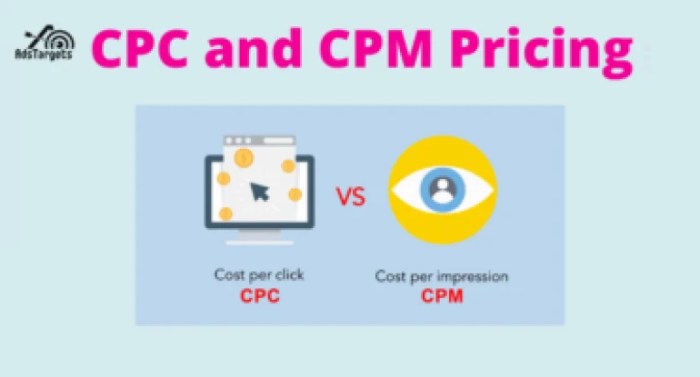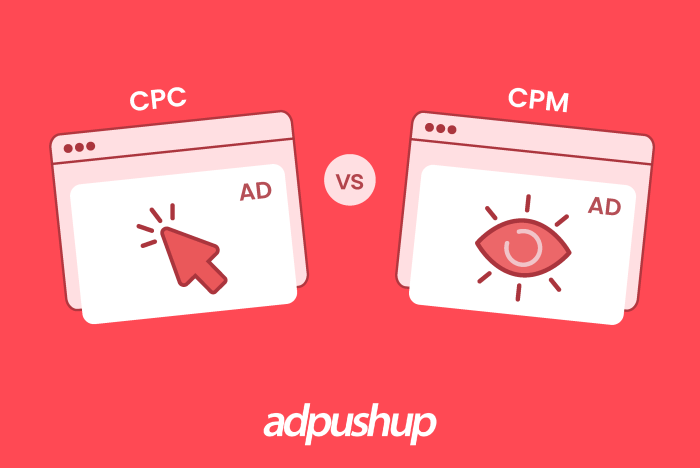Understanding CPC and CPM dives deep into the world of online advertising, shedding light on crucial metrics that drive marketing success. From deciphering the nuances of Cost Per Click to unraveling the mysteries of Cost Per Mille, this topic is a must-know for anyone navigating the digital marketing landscape.
Get ready to explore the intricacies of CPC and CPM and how they shape advertising strategies in today’s competitive market.
Understanding CPC and CPM

In the world of online advertising, understanding CPC (Cost Per Click) and CPM (Cost Per Mille) is crucial for creating effective marketing strategies. Let’s dive into the details of these two key metrics.
Definition of CPC and Calculation, Understanding CPC and CPM
CPC stands for Cost Per Click, which is the amount of money an advertiser pays for each click on their ad. It is calculated by dividing the total cost of the campaign by the number of clicks received. The formula for CPC is:
CPC = Total Cost / Number of Clicks
Explanation of CPM and Difference from CPC
CPM stands for Cost Per Mille, where “mille” refers to one thousand impressions. CPM is the cost an advertiser pays for one thousand views of their ad. The main difference between CPM and CPC is that CPM is based on impressions, while CPC is based on clicks.
Examples of Industries where CPC is More Beneficial
1. E-commerce: In the e-commerce industry, where the main goal is to drive conversions and sales, CPC can be more beneficial as advertisers only pay when a user clicks on the ad and potentially makes a purchase.
2. Lead Generation: For businesses focused on generating leads, CPC can be more cost-effective as they only pay for actual clicks that have the potential to convert into leads.
Advantages and Disadvantages of Using CPC and CPM in Advertising Strategies
- Advantages of CPC:
- Directly ties cost to performance through clicks.
- Allows for easy tracking of ROI.
- Cost-effective for campaigns focused on conversions.
- Disadvantages of CPC:
- May not be suitable for brand awareness campaigns.
- Competition can drive up click costs.
- Requires constant optimization to maintain effectiveness.
- Advantages of CPM:
- Useful for increasing brand visibility and awareness.
- Can be more cost-effective for campaigns focused on impressions.
- Helps in reaching a larger audience without the need for clicks.
- Disadvantages of CPM:
- Does not guarantee clicks or conversions.
- May not provide direct insight into campaign performance.
- Costs can add up quickly for high-traffic sites.
CPC vs. CPM

When it comes to comparing CPC and CPM, it’s essential to understand the different ways these pricing models can impact your advertising campaigns. Let’s dive into the details to see how they stack up against each other.
Cost-Effectiveness
- CPC: With Cost Per Click (CPC), you only pay when a user clicks on your ad. This can be more cost-effective if you have a high conversion rate and a well-optimized landing page.
- CPM: Cost Per Mille (CPM) charges you per thousand impressions, regardless of clicks. This can be beneficial for brand awareness campaigns where visibility matters more than clicks.
Reaching Target Audiences
- CPC: CPC can be effective in reaching a specific audience that is more likely to engage with your ad since you only pay for clicks.
- CPM: CPM can help you reach a broader audience and increase brand visibility, even if they don’t click on your ad immediately.
Ad Engagement Impact
- CPC: Higher engagement rates can lead to lower CPC costs, making it a more cost-effective option for campaigns with compelling ad content.
- CPM: While CPM doesn’t directly depend on clicks, higher engagement rates can still improve overall campaign performance and ROI.
Real-World Scenarios
- CPC Outperforms CPM: In a scenario where your goal is to drive direct conversions, CPC may outperform CPM by focusing on users more likely to convert through clicks.
- CPM Outperforms CPC: For brand awareness campaigns where visibility and impressions matter most, CPM can be more effective in reaching a wider audience.
Factors Influencing CPC and CPM: Understanding CPC And CPM
In the world of digital advertising, several factors play a crucial role in determining the Cost Per Click (CPC) and Cost Per Mille (CPM) rates. Understanding these factors is essential for advertisers to optimize their campaigns and achieve better results.
Ad Relevance and Quality Score:
Ad relevance and quality score are key factors that can significantly impact CPC and CPM pricing. Search engines and ad platforms like Google Ads use quality score to determine the relevance and quality of an ad. The higher the quality score, the lower the CPC and CPM rates are likely to be. Advertisers should focus on creating relevant and engaging ads to improve quality scores and reduce costs.
Competition and Industry Trends:
The level of competition in the advertising space and industry trends can also influence CPC and CPM costs. In highly competitive industries, advertisers may need to bid higher to secure ad placements, leading to increased CPC and CPM rates. Staying updated on industry trends and adjusting advertising strategies accordingly can help advertisers stay competitive and manage costs effectively.
Targeting Options:
The targeting options selected for an ad campaign can have a direct impact on CPC and CPM values. Advertisers can choose to target specific demographics, interests, or behaviors, which can affect the overall performance and cost of the campaign. By refining targeting options and reaching the right audience, advertisers can improve ad relevance and potentially reduce CPC and CPM rates.
Summary
- Ad relevance and quality score play a crucial role in determining CPC and CPM rates.
- Competition and industry trends can influence CPC and CPM costs.
- Targeting options directly impact CPC and CPM values by defining the audience reach.
